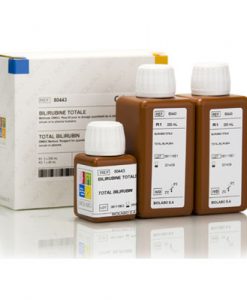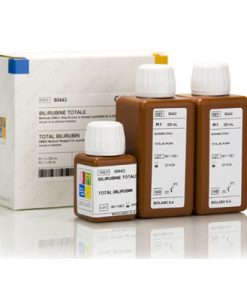
Cromatest Uric Acid Bio Chemistry Reagent
৳ 1,750৳ 2,000 (-13%)
In stock
Cromatest Uric Acid Bio Chemistry Reagent
Packaging Size: 2x50 ml
Origin: Spain
Brand : Cromatest / Linear
Packaging Type: Bottle
Test/Pack: 100 Test
Method: Enzymetic colorimetric method
Cromatest Uric Acid Bio Chemistry Reagent
PRINCIPLE
Uric acid is oxidized by uricase to allantoin with the formation of hydrogen peroxide. In the presence of peroxidase (POD), a mixture of ADPS* and 4-aminoantipyrine (4-AA) is oxidized by hydrogen peroxide to form a quinoneimine dye proportional to the concentration of uric acid in the sample.1,2
REFERENCE VALUES3
Serum ,Plasma:
| Men | 3.5-7.2 mg/dL (208-428 mmol/L) |
| Women | 2.6-6.0 mg/dL (155-357 mmol/L) |
It is recommended that each laboratory establishes its own reference range
Best Quality Diagnostic Products Buy from Medistore

REAGENT COMPOSITION:
The Monoreagent and Standard are ready-to-use.
STORAGE AND STABILITY:
Store at 2-8ºC.
The Monoreagent and Standard are stable until the expiry date stated on the label.
Discard the reagent if presents an absorbance over 0.300 at 550 nm against distilled water or if it fails to recover the declared values of control sera.
SAMPLES
Whenever possible medication should be suspended 12 hours before sample collection.
Hemolysis-free serum, EDTA or heparinized plasma, and urine (see Notes).
Uric acid in serum or plasma is stable up to 5 days at 2-8ºC and for 6 months at –20ºC.
REFERENCE VALUES3
Serum, plasma
Adults 37ºC up to 40 U/L (0.67 mkat/L
30ºC up to 25 U/L (0.42 mkat/L
Levels approximately twice the adult level are seen in neonates and infants; these decline to adult level by approximately 6 months of age.
It is recommended that each laboratory establishes its own reference range.
Buy Hematology Analyzer Reagent at best price from Medistore
QUALITY CONTROL
The use of a standard to calculate results allows to obtain an accuracy independent of the system or instrument used.
To ensure adequate quality control (QC), each run should include a set of controls (normal and abnormal) with assayed values handled as unknowns.
CLINICAL SIGNIFICANCE
Uric acid is the major product of the catabolism of purine nucleosides (adenosine and guanosine) from the purine metabolism pathway. Purines may be synthesized endogenously from the breakdown of nucleic acids or may be obtained from sources as diets in which nucleic acids are present.
An abnormal increase in the level of uric acid in the circulation above 7.0 mg/dL (0.42 mmol/L) is referred to as hyperuricemia
being the gout the major form of the ailment resulting in the deposition of urates in the soft tissues, especially in the joint areas. Increased levels may be also found associated with leukemia, toxemia of pregnancy and severe renal impairment.
Less common are the cases of hypouricemia where the concentration of uric acid is below 2.0 mg/dL (0.12 mmol/L). These cases are usually secondary to cases of hepatocellular disease, renal reabsorption defect, or overtreatment with uricosuric drugs used in the treatment of hyperuricemia.
NOTES
- Ascorbic acid disappears from serum samples in less than 90 5
- Uric acid in urine may be assayed on fresh random or timed (24-h) To prevent urate precipitation specimens are
brought to pH > 8 with 0.01N NaOH. Dilute urine 1:100 with distilled water before the analysis.
- Men and women on normal diets present values < 400-800 mg/ 24-h.4
ANALYTICAL PERFORMANCE
Linearity: Up to 500 U/L
Precision
| mg/dL | Within-run | Between-run | ||||
| Mean | 4.8 | 8.4 | 13.7 | 4.8 | 8.3 | 13.6 |
| SD | 0.04 | 0.08 | 0.7 | 0.05 | 0.07 | 0.14 |
| CV% | 0.9 | 0.1 | 0.6 | 1.0 | 0.8 | 1.0 |
| N | 10 | 10 | 10 | 10 | 10 | 10 |
Replicates: 10 for each level. Replicates: 10 for each level Instrument: CECIL CE 2021 for 10 days.
- Sensitivity. Using a 1:40 sample/reagent at 550 nm, 1 mg o uric will produce a net absorbance of approximately 0.016.
- Correlation. This assay (y) was compared with a similar commercial method (x). The results were:
N = 30 r = 0.995 y = 0.980 – 0.135
INTERFERENCES
-
- Highly icteric or hemolytic samples should be
- Lipemic samples may require a blank Use the same
volume of sample with isotonic saline in the place of the reagent.
- Sedatives and analgesics with strong reducing properties, like
buscapine or high dosis of ascorbic acid (Vitamin C), compete with peroxidase for the hydrogen peroxide giving low results.
- Other interfering compounds have been 3
MATERIALS REQUIRED
- Photometer or colorimeter capable of measuring absorbance at 550 ± 10 nm.
- Constant temperature incubator set at 37ºC.
- Pipettes to measure reagent and
PROCEDURE
- Bring reagents and samples to room temperature
- Pipette into labelled tubes:
TUBES
Blank
Sample
Standard
Monoreagent 1.0 mL 1.0 mL 1.0 mL Sample – 25 mL – Standard – – 25 mL 3.Mix and let stand the tubes 10 minutes at room temperature or 5 minutes at 37ºC.
- 4.Read the absorbance (A) of the samples and the standard at 550 nm against the reagent
The color is stable for at least 30 minutes protected from light
CALCULATIONS
Samples with concentrations higher than 20 mg/dL should be diluted 1:5 with saline and assayed again. Multiply the results by 5.
If results are to be expressed as SI units apply: mg/dL x 59.5 = mmol/L
REFERENCES
- Barham, and Trinder, P. Analyst. 97 : 142 (1972).
- Tamaoku, , Murao, Y. and Akiura, K. Analytica. Chimica. Acta. 136 : 121 (1982).
- Young, S. Effects of Drugs on Clinical Laboratory Tests. 4th Edition. AACC Press (1995).
- N.W. Clinical Guide to Laboratory Tests, 3rd Edition.
W.B. Saunders Co. Philadelphia, PA. (1995).
Fossati, P., Prencipe, L. and Berti, Q. Clin. Chem. 26 : 227 (1980
Brand
Chromatest
You must be logged in to post a review.






Reviews
There are no reviews yet.